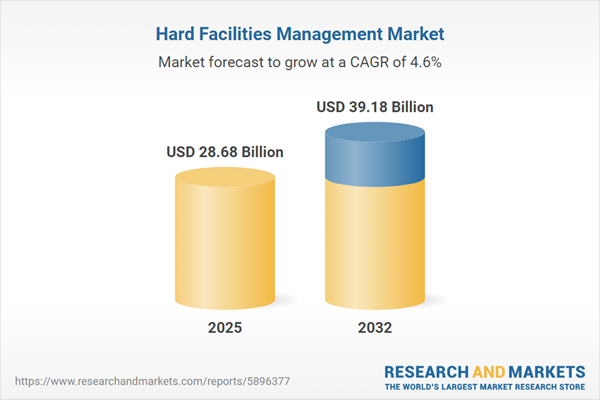Speak directly to the analyst to clarify any post sales queries you may have.
Senior leaders in hard facilities management are navigating rapid transformation as digital asset strategies, stricter compliance demands, and evolving procurement models reshape operational focus. Organizations face growing pressure to balance risk, meet regulations, and sustain performance across increasingly complex property portfolios.
Market Snapshot: Growth and Transformation in the Hard Facilities Management Market
The global hard facilities management market reached USD 27.44 billion in 2024 and is projected to expand to USD 28.68 billion in 2025 and USD 39.18 billion by 2032. With a compound annual growth rate of 4.55%, the market is moving steadily toward integrated digital asset management, predictive maintenance, and advanced service models. Driving this shift is widespread investment in technologies that improve operational resilience, optimize risk management, and support complex compliance obligations. Businesses are focusing on digital transformation to better coordinate resources and develop proactive solutions to both persistent and emerging facilities challenges.
Scope & Segmentation: Hard Facilities Management Market Coverage
- Service Types: Core offerings include carpentry and joinery, maintenance of electrical systems, heating, ventilation and air conditioning (HVAC), plumbing, flooring, painting, and decorating. These services safeguard structural integrity and safety, uphold regulatory compliance, and promote tenant satisfaction throughout diverse property portfolios.
- End User Industries: Commercial, healthcare, hospitality, industrial, residential, retail, and transportation sectors each present unique operational challenges for facilities management providers. Solutions are tailored to address industry-specific requirements related to safety, maintenance intensity, and compliance.
- Contract Types: Delivery models span in-house operations, integrated solutions, multi-service contracts, and single-service agreements. Selection of contract structure guides efficiency and aligns service delivery standards with portfolio complexity and local compliance requirements.
- Ownership Models: Public sector clients seek transparency, collaboration, and long-term compliance, while private sector organizations prioritize scalable and agile service models that support operational efficiency and business growth.
- Region Coverage: The sector operates across the Americas, Europe, Middle East and Africa, and Asia-Pacific. Differences in technology adoption, local regulations, and operational expectations influence market approaches within major countries including the United States, Germany, China, and Brazil.
- Key Companies Profiled: CBRE Group, Inc.; Jones Lang LaSalle Incorporated; Cushman & Wakefield plc; ISS A/S; Sodexo S.A.; EMCOR Group, Inc.; Atalian Global Services SAS; Bilfinger SE; SPIE SA; and Serco Group plc. These organizations set industry benchmarks for innovation and compliance.
Key Strategic Takeaways for Facilities Management Leaders
- Embracing digital asset management tools strengthens data-driven decision-making and enables more agile building operations, leading to improved performance.
- Sustainable procurement strategies and smart building technologies have become essential for adherence to tightening environmental and regulatory standards.
- Multi-service contracting can streamline operational administration and reinforce service consistency throughout asset portfolios, supporting standardized performance levels.
- Strengthening partnerships across disciplines and prioritizing workforce development helps address labor shortages and enhances operational continuity.
- Adopting flexible service agreements enables organizations to adapt to shifting compliance requirements and manage evolving operational risks more effectively.
Tariff Impact on Supply Chains and Operations
Planned tariff changes in the United States by 2025 are prompting organizations to adjust procurement strategies for building systems such as HVAC and electrical infrastructure. To adapt, facilities managers are collaborating closely with domestic and regional suppliers, increasing vendor oversight, and implementing stronger risk assessment practices. Clearly defined contract terms play a crucial role in maintaining business continuity and supply chain resilience amid shifting global market conditions.
Hard Facilities Management Market: Methodology & Data Sources
This analysis combines thorough secondary research, detailed regulatory review, and insights from executive interviews, further supported by targeted sector surveys. Real-world case studies enrich the findings, providing practical examples for addressing operational and compliance transitions within facilities management.
Why This Report Matters for Facilities Leaders
- Empowers decision-makers to implement digital solutions that enhance operational stability, increase compliance assurance, and build organizational resilience.
- Offers actionable guidance on optimizing vendor engagements and designing flexible contracts to limit supply chain risks and protect facility performance.
- Supports proactive planning for adoption of sustainable technologies and adjusting to regulatory changes, ensuring readiness for evolving stakeholder expectations across property portfolios.
Conclusion
Leveraging digital advancements and adaptive procurement approaches enables organizations to meet new compliance obligations and rising operational demands. Focusing on strategic, responsive solutions positions facilities leaders to sustain asset performance and value as the market evolves.
Additional Product Information:
- Purchase of this report includes 1 year online access with quarterly updates.
- This report can be updated on request. Please contact our Customer Experience team using the Ask a Question widget on our website.
Table of Contents
3. Executive Summary
4. Market Overview
7. Cumulative Impact of Artificial Intelligence 2025
Companies Mentioned
The companies profiled in this Hard Facilities Management market report include:- CBRE Group, Inc.
- Jones Lang LaSalle Incorporated
- Cushman & Wakefield PLC
- ISS A/S
- Sodexo S.A.
- EMCOR Group, Inc.
- Atalian Global Services SAS
- Bilfinger SE
- SPIE SA
- Serco Group PLC
Table Information
| Report Attribute | Details |
|---|---|
| No. of Pages | 198 |
| Published | November 2025 |
| Forecast Period | 2025 - 2032 |
| Estimated Market Value ( USD | $ 28.68 Billion |
| Forecasted Market Value ( USD | $ 39.18 Billion |
| Compound Annual Growth Rate | 4.5% |
| Regions Covered | Global |
| No. of Companies Mentioned | 11 |









